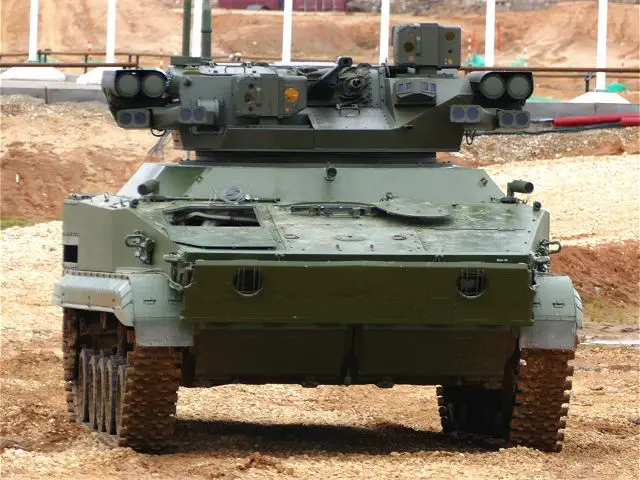Breaking news
Russia to integrate unmanned ground vehicles UGV with motor rifle battalions TASS 11207162.
| 2016
|
|
|||
|
Defence & Security News - Russia
|
|||
|
|
|||
| Russia to integrate unmanned ground vehicles UGV with motor rifle battalions. | |||
|
Russia`s Armed Forces will have to integrate unmanned ground vehicles (UGV) with motor rifle battalions, according to Russian defense analysts.Russia`s Armed Forces UGV integration efforts date back to the early 2000s. In 2000, the Ministry of Defense (MoD) initiated the implementation of the "Weapons Robotizing 2015" program.
|
|||
|
|
|||
 Russian Unmanned Ground Vehicle (UGV) based on BMD armoured chassis. Russian Unmanned Ground Vehicle (UGV) based on BMD armoured chassis. |
|||
|
|
|||
|
It was aimed at the conduction of comprehensive researches, setup of the scientific-technological capacities, and the designing of UGVs and unmanned aerial vehicles (UAV). Despite the implementation of "Weapons Robotizing 2015" and the successful trials of the UGVs and UAVs developed under the program, the MoD decided to cease all related works, having slowed down the progress in the area of unmanned ground vehicles. Meanwhile, the experience of the recent local conflicts has apparently shown the demand for small reconnaissance UGV, being able to locate a target and to send the gathered data to artillery and multiple launch rocket systems (MLRS) units. To this end, a motor rifle battalion should operate modern UGVs and UAVs. According to Russian defense analysts, the usage of small robots will increase the precision of artillery/rocket artillery fire by 40-45%.
At the same time, Russia`s Armed Forces will have to operate attached combat unmanned vehicles, as well as the reconnaissance ones. As the specialists suppose, each motor rifle battalion will incorporate an unmanned asset consisting of about 30 servicemen, five mobile command-and-control (C2) posts, two reconnaissance UGVs, six unmanned combat ground vehicles (UCGV) armed with 122mm unguided rockets, six UCGVs armed with 80mm unguided rockets, six UCGVs armed with 152mm 9M133 Kornet (NATO reporting name: AT-14 Spriggan) anti-tank guided missiles (ATGM), three unmanned combat aerial vehicles (UCAV) armed with 9M133 Kornet ATGMs, two reconnaissance UAVs, and two UAVs equipped with laser designators and radars. Hence, the proposed unmanned asset will be armed with 120 140mm and 480 80mm unguided rockets, as well as with 30 9M133 Kornet ATGMs. Unguided rockets are supposed to be the primary weapon of the aforementioned unmanned vehicles. A 140mm rocket has an effective firing range of 9,500 m, while an 80mm rocket - about 5,500 m. Kornet ATGM can eliminate both light and heavy armoured vehicles at distances up to 5,000 m. The reconnaissance UAVs of a motor rifle battalion are supposed to have an operational range of 100 km (or a flight endurance of 3 hours). According to the concept, the vehicles of the aforementioned unmanned asset should transfer navigational and multimedia data at distances up to 20 km and at speed of 345 kb/s. The land-based elements of the system will have a road speed of about 38 km/h. If the aforementioned program is completed to full extent, it will significantly beef up the combat effectiveness of Russian Armed Forces` motor rifle battalions. Its implementation will result in the increase of a unit`s firepower by 30-130%, the reduction of munitions expenditures by 20%, and the establishing of a single network to unite all unmanned vehicles on the modern battlefield. The combat deployment of the aforementioned unmanned asset will require about 15 min. It should be noted that the integration of UCGVs and UCAVs will allow slimming down of a battalion`s personnel by 25-30%, while the precision of fire will be increased by 100-110%. Russia`s efforts to equip the national Armed Forces with unmanned vehicles are noteworthy. Despite harsh economic conditions and the proposed restriction of the funds allocated to meet the MoD`s requirements in the robotics area, they have been crowned with success - at least, as of mid-2016. The indigenous defense industry has already developed a prototype of heavy UCGV designated as Uran-9. It is armed with 30mm 2A42 automatic cannon and guided weapons (in particular, 9M120 Ataka (AT-9 Spiral-2) heavy anti-tank missiles or 9K338 Igla-S (SA-24 Grinch) surface-to-air (SAM) missiles). Nerekhta small unmanned ground platform is supposed to be equipped with single 12.7mm 6P49 Kord heavy machinegun. Russia has also developed an engineer UGV (designated as Uran-6), being able to conduct mine clearance operations. At the same time, the industry has faced several troubles in efforts to develop a reliable medium-range long-endurance (MALE) UAV. Hence, the aforementioned concept seems to be non-realizable in a short-term perspective. |
|||
|
|
|||
|
© Copyright 2016 TASS. All rights reserved. This material may not be published, broadcast, rewritten or redistributed.
|
|||



















